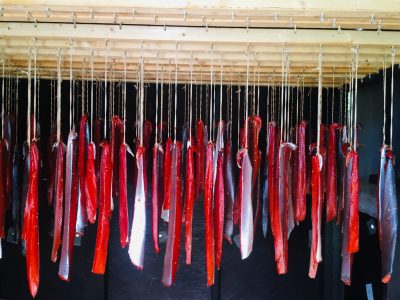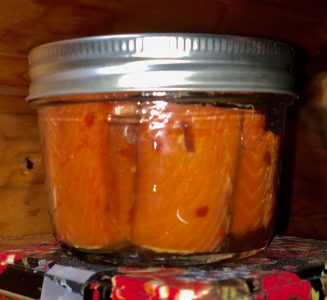Everyone in Alaska smokes salmon, right? It’s in our blood. We just know what to do. Chances are you have a section in the food preservation department of the garage that is dedicated to salmon smoking paraphernalia. This department we visit throughout the year to replenish jars or stash more Food Saver bags when we find them on sale, but at a minimum we take inventory right before the salmon runs are expected so we aren’t caught short handed. There’s nothing worse than having fresh salmon ready to brine, running to the store for canning salt, only to find that section of the grocery store shelf empty! Then one must decide whether to make a 180 mile round trip to Soldotna (where the shelves will also likely be empty) or a 250 mile r/t to Anchorage, all the while your fresh fish are losing their freshness.

We are generally so well organized that when I decided to write about smoking salmon for the Alaska Master Gardener Online class blog assignment, I thought it would be easy. Not so. As my mother would’ve said, “Oh, honey!’ a term she used at times when I tried to emulate something she did effortlessly, but I bollixed miserably. This recipe was never in writing. It has been passed around my family for generations, and each member has his/her own variation in his/her head, which they claim to be superior. I use a smokehouse that was built by my late eldest brother, refurbished by my youngest son, and customized by my husband and me. It is seasoned impeccably. My sons and their spouses, nephews, niece and friends all use it and know the routine. Yes, I thought it would be easy. After no less than 50 iterations, here it is, to the best of my ability to write it down.
This recipe is for canned smoked salmon. This is for my smokehouse. It is for my location in Alaska. Yours will differ. Improvise and modify as necessary. The universal step is to develop a relationship with your smoker. Here’s the rest.
What you will need:
A device to smoke with (Little Chief, dead refrigerator, custom smoke house)
20 Resurrection Bay sockeyes, 12 Kenai/Kasilof River sockeyes or 12 Resurrection Bay cohos, filleted
200 strings 10-12′ long (parcel post or other small twine)
2-3 boxes canning and pickling salt
4 bags alder chips or the equivalent amount of homemade chips
6-7 cases half pint, wide mouth jars
1 cooler
1 laundry basket that fits inside the cooler
1 potato
knives and sharpening tools
1 large cutting board
1 electric hot plate
1 box fan
Optional seasonings: Black pepper, red pepper, garlic, ginger, soy sauce.
Preparation:
Tie strings into loops.
Inventory supplies.
Prepare smokehouse by cleaning, testing hotplate and fan, and covering floor with red rosin paper.
Check the weather.
Do it:
Make the brine — Put some water in the cooler(s), add salt till the mixture floats the potato.
Set up your system – Knives, cutting board, knife sharpener, cooler, strings, ingredients, trash can, etc.
Cut each fillet into strips — 4-5 strips per fillet depending on size.
Tie a string on each strip. Make sure grain of meat goes down, not up.
Layer in laundry basket.
Place basket in cooler of brine.
Brine for 30-40 minutes.
Remove strips from brine and hang in smoker.

Air dry by opening the wings of the smoker until fish has a slight glaze. This is where nature comes into play. If weather is dry and breezy, this phase is about 1 day. Try to avoid smoking in the rain, but if you have no choice, use a fan in this process.
Cold smoke the fish 3-4 times a day for 3-5 days. I use an electric hotplate with a cast iron skillet. Heat it just enough to get the chips smoking and turn off the power. The hot skillet will keep the chips smoking but not cook the fish. At night, air or fan the fish.
Canning intensifies flavor and dryness, so avoid smoking too long.
The Grande Finale:
While fish is smoking, get jars and pressure cooker ready for production.
Remove fish from smoker
Remove strings.
Cut into jar size pieces.
Prepare and pack jars according to Kerr/Ball directions.
Pressure cook according to UAF Cooperative Extension guidelines.
Enjoy!

This is my favorite style of smoked salmon. Thank you so much for posting your recipe and method. I AM going to DO this. I just need to find an old refrigerator ;o)